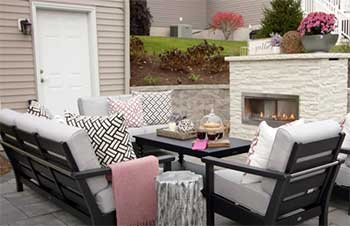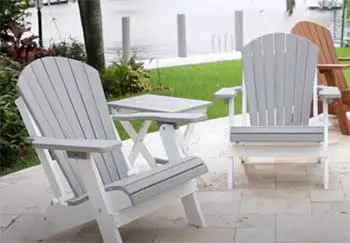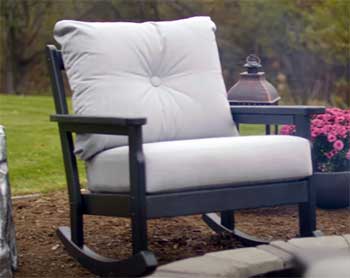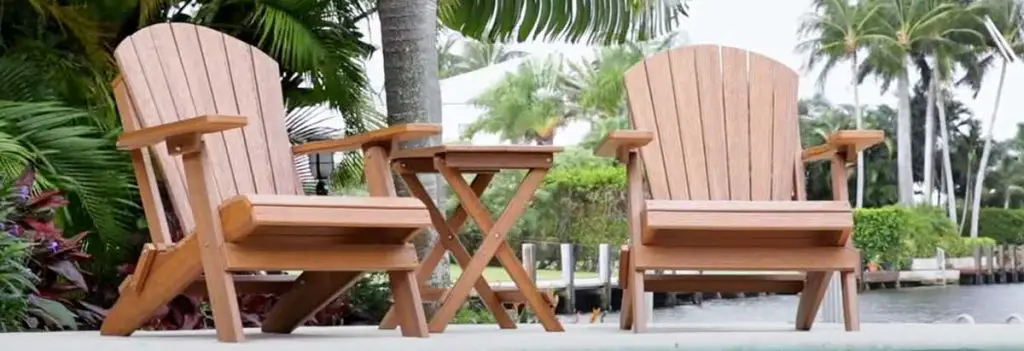If you’re in the market for outdoor patio furniture, you’ve likely come across POLYWOOD and DuraWeather as top contenders. Both brands make their furniture from durable all-weather materials designed to withstand the elements.
But how exactly do they compare in terms of quality, style, and value?
I’ve owned furniture from both POLYWOOD and DuraWeather for years. From my personal experience, here’s an in-depth look at how these two brands stack up across the key factors that matter most when shopping for outdoor patio sets.
A Brief Comparison Table
| Factor | POLYWOOD | DuraWeather |
| Materials | HDPE poly lumber with recycled plastic and natural additives | PermaPoly resin formula |
| Weather resistance | Extremely durable against sun, rain, snow, salt, heat, and cold | Extremely durable against elements |
| Hardware | Marine grade stainless steel and zinc coated steel | Marine grade stainless steel and zinc coated steel |
| Fade resistance | Retains vibrant colors longer term | Resists fading well but not as long as POLYWOOD |
| Style variety | Extensive collections from modern to classic looks | Wider range of cushions and accent pieces for more customization |
| Chair comfort | Slatted appearance without flex like real wood | Better flex and “give” closer to natural wickers |
| Table tops | Harder surface great for dining utility | More resilience and flex for casual comfort |
| Cleaning | Resists most dirt, spills, etc. with basic wipe downs | Resists most dirt, spills, etc. with basic wipe downs |
| Price | Mid-upper tier pricing, excellent value for longevity | Budget-mid tier pricing, great value in lower price points |
| Warranty | 20 years residential | 10 years residential |
Overview of POLYWOOD and DuraWeather
- What is POLYWOOD?

POLYWOOD is made from high-density polyethylene (HDPE) lumber containing recycled plastic and natural additives.
The result is a wood-like material perfect for outdoor use because it doesn’t warp, crack, chip, peel, or splinter like natural wicker and wood can.
Most POLYWOOD furniture assembles quickly with basic tools, requires little maintenance, and cleans easily by wiping down. It’s also backed by a generous 20-year residential warranty. With styles ranging from modern to traditional available in a spectrum of colors, it lends itself well to nearly any outdoor space.
- What is DuraWeather?
DuraWeather uses a proprietary poly lumber formula called PermaPoly. It contains a high concentration of synthetic polymers mixed with inorganic fillers. This makes furniture that’s low maintenance, fade resistant, and remains cool to the touch even in hot, direct sunlight when many other materials would be uncomfortably hot.
Like POLYWOOD, most DuraWeather patio furniture assembles with minimal tools and time required. It’s able to withstand a wide range of temperatures and conditions while resisting common damage. DuraWeather products come with a 10-year residential warranty.
Comparison of Quality and Durability
When choosing outdoor patio furniture, longevity is a primary concern. You want it to last for years while still looking great with minimal upkeep. Both POLYWOOD and DuraWeather offer exceptional quality and durability.
- Materials

POLYWOOD HDPE lumber has excellent resistance to weathering, fading, staining, corrosion, and other damage typically wreaked by the elements.
It retains its vibrant color for years with minimal upkeep required.
DuraWeather PermaPoly similarly stands tough in the face of what Mother Nature dishes out.
It’s crushed coral and coir fibers enable it to better mimic natural wicker in look and feel with exceptional durability.
From a structural integrity standpoint, these poly lumber materials are heavier and more rigid than wicker. There’s no stretching or sagging over time. Joints and moving parts like swivels and rockers retain stability for years.
- Hardware
The screws, bolts, moving parts, and other hardware components also play a pivotal role in product longevity.
Both POLYWOOD and DuraWeather use marine grade stainless steel and zinc coated steel when iron alloy hardware alone would succumb to rusting. Where weaker plastic or nylon components could become brittle and break down over seasons of use, these brands opt for ultra resilient materials.
- Weather Resistance
Of course weather resistance is paramount for outdoor furniture. Both stand miles ahead of natural wicker, wood, or metal when it comes to combatting sun, rain, salt, chlorine and other outdoor exposure damage.
They retain color and integrity for years rather than months or a single season like less durable materials would. Neither becomes overly hot in sunlight or prone to growing mold, mildew, or other microbes from moisture.
Snow, hail, and debris won’t permanently mark or dent them like it could with some painted metals or delicate wicker.
The one weather caveat to note is that PermaPoly can become slightly more slippery when wet. The tradeoff for PermaPoly’s otherwise extremely durable and low maintenance qualities makes this an easy issue to overlook or manage with reasonable care to wipe down surfaces before use when wet.
- Fade Resistance
POLYWOOD often retains its original vibrant colors better than DuraWeather over years of sun and weather exposure based on my experience.
However, DuraWeather combats fading exceptionally well compared to any natural outdoor furniture material. Periodic cleaning combined with occasionally moving furniture to expose all sides more evenly to UV rays makes a difference too.
If keeping original colors is a high priority, POLYWOOD may hold the edge. But both suppress fading far longer than almost any other material.
- Design and Style Variety
Both POLYWOOD and DuraWeather offer designs ranging from modern contemporary to classically elegant looks. You’ll find plenty of patio furniture collection options across various material looks.
In terms of replication, POLYWOOD more closely mimics painted wood tones while DuraWeather better achieves natural wicker aesthetics. DuraWeather also offers a wider range of cushions and accent options to match different decors.
For versatility and choice, DuraWeather gains a slight edge. But both brands deliver styles versatile enough to coordinate with most outdoor spaces.
Comfort and Ergonomics
Outdoor furniture needs to be comfortable as well as handsome and durable. POLYWOOD and DuraWeather both deliver excellent support and ergonomics, but they achieve this through different means.
- Cushions

Most POLYWOOD collections don’t include cushions.
The furniture I’ve purchased over the years has removable seat cushions covered in fade and water resistant Sunbrella outdoor fabric.
The individually pocketed coil cushions maintain shape and comfort for seasons.
With DuraWeather, I prefer their thicker box border cushions in outdoor mesh fabric.
The built-in headrest design offers better neck support and the mesh fabric stays cooler against skin in hot weather.
Both brands offer optional cushion and fabric upgrades if the in-box cushions don’t meet your preferences.
- Chair Design
POLYWOOD furniture retains a more classic slat appearance thanks to its wood-like aesthetics. Curved, contoured, and mixed width slats follow the natural movement and flow you expect with patio furniture.
The one difference is that unlike real wood, POLYWOOD doesn’t flex. This makes some chairs and chaise lounges more rigid. Individual preferences vary regarding whether no give is better or worse for comfort.
In contrast, because DuraWeather sets out to mimic wicker, its furniture better achieves the structure and flex expected from woven furniture. The way strands give just slightly enhances comfort without compromising support. Paired with its cushions, DuraWeather ultimately wins my vote for long term lounging comfort.
Both achieve ergonomic designs tailored for leisurely outdoor living across various collections. But DuraWeather’s takes comfort a step further.
- Table Tops
Table tops represent another ergonomic difference in these materials. POLYWOOD has an inherently harder, more solid surface. This makes it fantastic for dining since things rarely tip. But the hard surface loses points for comfort factor if you ever plop bare feet up for casual conversation.
In contrast, DuraWeather’s tops offer slightly more flex and a resilience closer to wood or wicker. You trade off a touch of stability for comfort and an authentic natural material feel.
For dining, POLYWOOD rules. But DuraWeather tables foster more of an inviting, relaxed vibe perfect for conversation nooks.
Maintenance and Care
Easy upkeep is one of the major draws to both POLYWOOD and DuraWeather outdoor collections. You’ll spend less time maintaining the furniture and more time enjoying your outdoor living space.
- Cleaning
Both POLYWOOD HDPE lumber and DuraWeather PermaPoly resist most dirt, spills, and environmental stains with a simple wipe down. Periodic soap and water sponge baths rejuvenate the look.
If a spill like wine, coffee, or mustard sets before cleanup, some gentle scrubbing with baking soda paste lifts most stains. Mildew stains on DuraWeather sometimes require white vinegar or special wicker cleaner for removal but this isn’t common under normal care.
Both also play friendly with salt water, chlorine, and other chemicals that deteriorate typical outdoor furniture. Maintenance really comes down to occasionally wiping down to keep things looking freshly clean.
- Storage
Cold and off-season storage means little to POLYWOOD and DuraWeather products. Leave them outside year round without worry or keep in a shed or garage over winter. Their materials withstand temperature extremes, winter precipitation, dry summer heat, dust, dirt, wind, and other exposure while stored with minimal fuss.
I prefer to keep cushions protected in furniture covers or brought indoors between seasons. But the furniture itself survives storage handsomely either way.
Value Comparison
Value balances quality and cost. With exceptional durability, weather resistance, low maintenance, and ample style choice, both POLYWOOD and DuraWeather deliver outstanding patio furniture value.
- Cost
POLYWOODfetchercker lists slightly higher in average upfront cost but delivers value comparable to DuraWeather. When you account for the 20 year warranty and cost per year of use over decades, any difference diminishes.
Budget-wise DuraWeather does offer more collections specifically designed to meet lower price points. So if squeezing maximum seating into a tight budget, DuraWeather may win out. They save costs designing hollow frames to mimic wicker that can sometimes feel flimsy compared to POLYWOOD.
For the best value ratio of cost to longevity, POLYWOOD excels. But DuraWeather makes outdoor living more affordable at the tradeoff of potentially shorter useful furniture life. Keep your specific budget and years of intended use in mind when choosing between the two.
Additional Furniture Brand Comparisons
Beyond DuraWeather, how does POLYWOOD compare to other top outdoor furniture brands? Here’s a quick look at how a few competitors stack up.
O.W. Lee – Known for high end outdoor furniture, O.W. Lee commands luxury prices approaching the cost of indoor furniture. POLYWOOD delivers better durability and maintenance value but can’t match some exclusive designer styles and exotic natural material furniture artistry from O.W Lee.
Treasure Garden – Focusing specifically on umbrellas and other shade accessories, Treasure Garden brings innovative durability features to their market niche. But they don’t offer the complete furniture package like POLYWOOD.
Woodard – As a heritage brand, Woodard carries rich American craftsmanship history and premium quality. But their range still primarily focuses on metal and high end wicker furnishings. POLYWOOD’s wider material and style options give a competitive edge.
Target/Walmart – Big box patio furniture wins on price tag alone but rarely matches the quality, longevity, and low maintenance aspects where POLYWOOD excels. Great if replacing every couple years doesn’t frustrate you when pieces wear down.
POLYWOOD Buying Considerations

If you’ve decided POLYWOOD offers your ideal combo of quality and value, keep these key factors in mind while shopping:
- Style
Think about the look you envision for your space. Measure the area to ensure proportions allow room to navigate around pieces comfortably. Browse POLYWOOD’s style gallery online or their available collections at local dealers to get ideas.
Modern, contemporary, classic, casual, and transitional styles are all available. Compare colors that pop against surroundings or blend seamlessly. View product dimensions to accurately gauge sizing and scale.
Don’t rush the browsing process – their website offers plenty of lifestyle photos to spark vision and ideas.
- Purpose
How will you use your POLYWOOD furnishings? Casual family meals, intimate couple’s corners, poolside lounging, fireside chatter?
Dining sets allow gathering 6-8 comfortably around a table. Deep seating sectionals create room for bigger groups or cozy couples spots. Chaises catch the sun alongside a pool deck. Swivel rockers surround a fire feature. Bar sets keep refreshments and nibbles handy.
Match form with function by choosing POLYWOOD pieces that align with your intended activity needs.
- Placement
Picture exact placement on your patio, balcony, or in the yard. Measure to ensure adequate clearance exists. Avoid common obstructions like ceiling fans, overhangs, sconces, trees and branches, storm doors, etc. that could limit positioning.
Consider amount, angles, and times of sunlight exposure based on placement. Some areas stay shaded while others bake in full sun at peak hours. Over time furniture placed consistently in harsh sunlight fades faster even when resistant.
Basic protection from prevailing winds and rainfall will also maximize longevity of your POLYWOOD set.
Always keep fire features safely distant to prevent ember damage. Consider proximity to other amenities like kitchen access, electrical outlets if adding mood lighting, water sources for cleaning spills before they might stain, etc.
Optimal furniture placement sets your arrangement up for years of enjoyment.
DuraWeather Buying Considerations
Ready to invest in all-weather DuraWeather furnishings? Use this expert advice when making your purchase decisions:
- Intent
Assess how your family anticipates using DuraWeather patio furniture. Do you frequently host large gatherings in need of ample open seating? Does a small bistro set better suit morning coffee enjoyed as a couple? Will kids and pets claim pieces for impromptu play and relaxation?
Choose between sectionals, dining sets, individual rockers, and more based on regular activities and visitors to shape the form and function that best fits actual use.
Measure the designated area to allow for comfortable conversational space between pieces along with circulation room. An accurate sense of dimensions and layout ensuresoptimal user experience.
- Style & Color
With myriad style and color options, explore DuraWeather collections that define your unique aesthetic. Compare colors in natural daylight when possible to verify tones complement surroundings.STYLE & COLOR
Browse online galleries showing collections in real lifestyle settings. Note colors that recede or pop against common surroundings like plants, fencing, structures.
Aim for cohesive style blending DuraWeather patio furniture with existing decor. But don’t shy from playful pattern or color pops if it suits the overall vibe you hope to achieve in your space.
- Placement
Consider the angles and amount of sun exposure in different external areas around your home. Compare shade and sunlight throughout the average day.
Furniture placed in consistently hot direct sun often fades faster than pieces shielded by periodic shade. You’ll still enjoy years of beauty but rotating placements can extend vibrancy even longer.
Also measure entry points from doorways and pathways allowing ample circulation. Ensure adequate clearance from overhead roof lines, ceiling fans, sconces, trees and branches, etc. that could obstruct seating.
Keep fire features safely distant to avoid ember damage.
Frequently Asked Questions (FAQ)
Some leading outdoor furniture brands offering similar quality and value benchmarks as POLYWOOD include:
Brown Jordan – upscale designer brand specializing in aluminum, wicker, and teak furnishings.
Gronomics – focuses primarily on modular plastic furniture often used in commercial settings.
Cast Classics – known for cast aluminum pieces inspired by historic designs.
The only potential downsides of POLYWOOD outdoor furniture include:
1. Expense if shopping on a very tight budget
2. Lack of deep cushioning for some chair and sofa designs
3. Slight inflexibility compared to some natural wicker styles
But for most shoppers, the PROs of POLYWOOD far outweigh these few CONs.
DuraWeather Poly is a proprietary name for High Point’s custom formulated poly lumber resin material. Its standout qualities include:
1. Resilience against temperature extremes
2. Mold, chip, crack, peel, and UV resistance
3. Built to mimic wicker in look, feel, structure
4. Cushioned comfort beyond typical rigid plastics
No, Amish communities prefer natural building materials like wood or aluminum to synthetic poly lumber furniture. But for modern consumers embracing outdoor living ease, POLYWOOD offers exceptional convenience and longevity.
Closing Remarks
In summary, both POLYWOOD and DuraWeather offer exceptional quality and durability for outdoor spaces. POLYWOOD excels at fade resistance and mimicking wood for style variety. DuraWeather edges out comfort and customization ability.
Shoppers prioritizing budget find greater value in lower price points from DuraWeather as well. Ultimately you can’t go wrong for low maintenance and weather durable outdoor furniture with either brand.

Hi!
What is the weight maximum of a person sitting on a chaise for POLYWOOD? DURAWEATHER’s weight limit, I believe is 400 lbs.
Thanks,
Luba